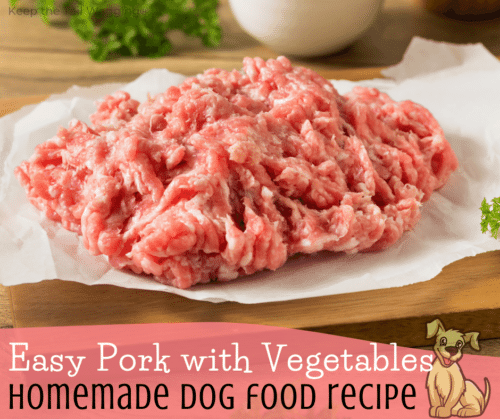Keep the Tail Wagging is supported by pet parents. I occasionally earn a commission (at no additional cost to you) when you click through an affiliate link to one of my favorite products. Thank you for your support. Read More
The other day, someone on social media mentioned that raw goat's milk is an excellent source of taurine. Something I had forgotten. This discussion inspired me to learn about other familiar sources of taurine for dogs.
What is Taurine?
Taurine is an amino acid that occurs naturally in humans; most mammals produce taurine naturally, except cats, which need taurine in their diet (obligate carnivores). There was a growing debate about taurine, DCM, and grain-free diets, partly due to ingredients (e.g., legumes) in processed dog food that act as anti-nutrients and block the absorption of taurine, which is said to be a contributing factor in heart disease in some dogs.
Why Dogs Need Taurine in Their Diet
Taurine assists several systems in the body, including the eyes, heart, and immune system. When a dog's system is low in taurine, the heart becomes weaker and can't pump blood through the system effectively.
Other benefits of taurine include:
- Neurological development, including supporting the central nervous system and eyes.
- Regulates the level of water and minerals in the blood
- Antioxidant properties
- Forming bile salts (an essential part of digestion)
- Prevent muscle degeneration
- Prevent arrhythmias
Source: HowlToTheChief.com – The Great Grain-Free/Taurine Debate
Are Raw Fed Dogs at Risk for DCM?
Absolutely! DCM is a risk if a dog has a genetic predisposition for dilated cardiomyopathy or eats a diet deficient in taurine. A dog's age or size may also contribute to reduced absorption of taurine, as older dogs produce fewer digestive enzymes and large-breed dogs produce taurine at a slower rate than small dogs.
It's comforting to think that once we transition our dogs to a raw food diet, we've done the work, and now our dogs will live until the ripe old age of 35, but switching our dogs' diet is just the beginning.
Three ways to extend the life of our dogs include…
Feed a Nutritious Fresh Food Diet
A diet deficient in essential nutrients won't cut it, especially as those deficiencies accumulate over time. Dog owners can ensure that they're meeting their dog's nutritional needs by feeding a variety of proteins and other ingredients, working with a canine nutritionist, or using meal formulation software.
Dogs fed a plant-based diet are prone to taurine deficiencies without supplementation because this is not an amino acid found in plants. Dogs fed a cooked diet may need supplementation as cooking reduces (not eliminates) the amount of taurine and other nutrients.
Many DIY and commercial raw blends are frozen for a period of time. I've been told that after about three months, nutrients in raw meat begin to break down, but not by enough to cause concern. I choose to either mix the older meat with new meat or make dog treats from older meat.
Regular, Daily Exercise
Our dogs need regular, daily exercise. How much depends on the breed and their age. Maggie, the longest-living dog that died in 2016 at 30 years, ran more than 12 miles daily on her farm. She kept her human company as he worked their property. Source: PetSnacks.com – How One Farmer Added 15 Years to His Dog's Life
Dogs can't get enough exercise when left in their yard. Therefore, a standard recommendation for daily exercise is two 45-minute walks daily. I take my dogs on two walks daily. Their first walk is 30 minutes to an hour on a trail where they can walk and sniff. The second walk is around our property, where they explore, and we play fetch and other games.
Focus on Gut Health
A focus on gut health not only improves digestion it also supports a healthier immune system. I do this through diet and supplementation. My dogs eat raw and gently cooked foods, and I add pre/probiotics and medicinal mushrooms to their meals.
10 Sources of Taurine for Dogs
There are many natural sources of taurine; the following foods contain the highest amounts, according to the National Institutes of Health that I feed my dogs.
- Raw Goat's Milk / Kefir
- Fish
- Chicken and Turkey (dark meat – thighs, drumsticks)
- Pork Loin and Picnic Ham
- Beef
- Organ Meat (liver and heart)
- Lamb (dark meat)
- White Fish
- Mussels
- Oysters
A food I expected to be at the top of my list is eggs. I was surprised to learn that this may be a misconception. According to The Whole Dog Journal, “eggs are high in methionine and cysteine (taurine’s precursors) but have little taurine.”
Sources for This Blog Post…
Because taurine, grain-free, and DCM are hot topics, I want to include the resources that helped me write this blog post:
- The Great Grain-Free Taurine Debate, HowlToTheChief.com
- What Is Taurine? Benefits, Side Effects and More, Healthline.com
- The potential protective effects of taurine on coronary heart disease, National Institutes of Health
- July 2018 Statement made by Answers Pet Food on Facebook
- Diet, Dogs, and DCM, Whole Dog Journal
- Review of canine dilated cardiomyopathy in the wake of diet-associated concerns, Oxford Academic Journal of Animal Science
- Research compiling 150+ studies finds no conclusive link between grain-free diets, DCM in dogs, PetFoodProcessing.net

















Thank You for all your information you give us. I am learning so much from you.